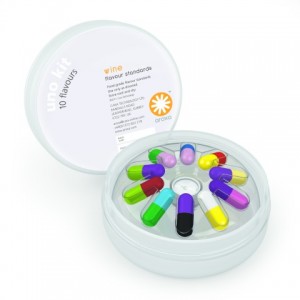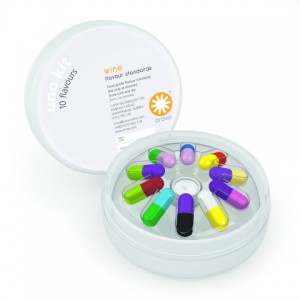Wine flavour capsules
August 24th, 2012 | Tasting
 Wine aroma kits have been around for some time, indeed I remember buying my first ‘Nez du Vin’ roughly 20 years ago. The kit consisted of small vials of oils impregnated with some of the more common fragrances found in wine. Indeed some of the kits were actually regionalised, and you could buy one that represented a specific (French) wine region – in other words the smells associated with the grape varieties of that particular region. Nicely packaged, with colour pictures (like large playing cards) explaining each individual aroma. They were not cheap, and also did not last that long once they had been opened for the first time – like fine perfumes they would eventually age and start to fade.
Wine aroma kits have been around for some time, indeed I remember buying my first ‘Nez du Vin’ roughly 20 years ago. The kit consisted of small vials of oils impregnated with some of the more common fragrances found in wine. Indeed some of the kits were actually regionalised, and you could buy one that represented a specific (French) wine region – in other words the smells associated with the grape varieties of that particular region. Nicely packaged, with colour pictures (like large playing cards) explaining each individual aroma. They were not cheap, and also did not last that long once they had been opened for the first time – like fine perfumes they would eventually age and start to fade.
However, there is now a new kid on the aroma block – the Aroxa sensory kit. The way that this kit performs is completely different to its predecessors, and aimed more at the profession wine taster who wants to train his or her palate. The system contains a series of capsules, each one containing a purified form of the molecule responsible for some of the more common flavours and taints found in wine. To use them you quite simply break the capsule and pour it into a wine. The capsules are not actually given the name of a particular smell such as honey, violet or vanilla, but they are give the chemical name of the molecule instead e.g. ethyl phenylacetate, β-ionone or vanillin (the latter example being the most obvious of the three). The system’s creator, Dr Bill Simpson, thinks that his method will help to unify the way in which wines are described, replacing the current somewhat vague, but elegantly crafted prose. For example, one person might say grapefruit, whilst another will say citrus, but then using Dr Simpson’s system, both would be trained to say ‘linalool’. Accurate perhaps, but certainly not quite as lyrical…. Dr Simpson argues that a professional taster should first know the real name of the compound, and then find a way to convey it to their own particular target audience.
The real beauty of this Aroxa kit is that it allows trainers to actually test the sensitivity of any given group of students, and their ability to detect particular aromas. As the molecules are actually added to the wines then it also allows them to be tasted blind, giving a much more objective result.
The downside? Price! Ten small capsules for a single tasting will set you back £69 (approx $110). A kit of eight flavours for a group tasting of ten people (viable for only 20 hours), is a ‘snip’ at only £499 (nearly $800), but at least it does include free shipping! It’s on my Christmas list…..
 Wine aroma kits have been around for some time, indeed I remember buying my first ‘Nez du Vin’ roughly 20 years ago. The kit consisted of small vials of oils impregnated with some of the more common fragrances found in wine. Indeed some of the kits were actually regionalised, and you could buy one that represented a specific (French) wine region – in other words the smells associated with the grape varieties of that particular region. Nicely packaged, with colour pictures (like large playing cards) explaining each individual aroma. They were not cheap, and also did not last that long once they had been opened for the first time – like fine perfumes they would eventually age and start to fade.
Wine aroma kits have been around for some time, indeed I remember buying my first ‘Nez du Vin’ roughly 20 years ago. The kit consisted of small vials of oils impregnated with some of the more common fragrances found in wine. Indeed some of the kits were actually regionalised, and you could buy one that represented a specific (French) wine region – in other words the smells associated with the grape varieties of that particular region. Nicely packaged, with colour pictures (like large playing cards) explaining each individual aroma. They were not cheap, and also did not last that long once they had been opened for the first time – like fine perfumes they would eventually age and start to fade.
However, there is now a new kid on the aroma block – the Aroxa sensory kit. The way that this kit performs is completely different to its predecessors, and aimed more at the profession wine taster who wants to train his or her palate. The system contains a series of capsules, each one containing a purified form of the molecule responsible for some of the more common flavours and taints found in wine. To use them you quite simply break the capsule and pour it into a wine. The capsules are not actually given the name of a particular smell such as honey, violet or vanilla, but they are give the chemical name of the molecule instead e.g. ethyl phenylacetate, β-ionone or vanillin (the latter example being the most obvious of the three). The system’s creator, Dr Bill Simpson, thinks that his method will help to unify the way in which wines are described, replacing the current somewhat vague, but elegantly crafted prose. For example, one person might say grapefruit, whilst another will say citrus, but then using Dr Simpson’s system, both would be trained to say ‘linalool’. Accurate perhaps, but certainly not quite as lyrical…. Dr Simpson argues that a professional taster should first know the real name of the compound, and then find a way to convey it to their own particular target audience.
The real beauty of this Aroxa kit is that it allows trainers to actually test the sensitivity of any given group of students, and their ability to detect particular aromas. As the molecules are actually added to the wines then it also allows them to be tasted blind, giving a much more objective result.
The downside? Price! Ten small capsules for a single tasting will set you back £69 (approx $110). A kit of eight flavours for a group tasting of ten people (viable for only 20 hours), is a ‘snip’ at only £499 (nearly $800), but at least it does include free shipping! It’s on my Christmas list…..


